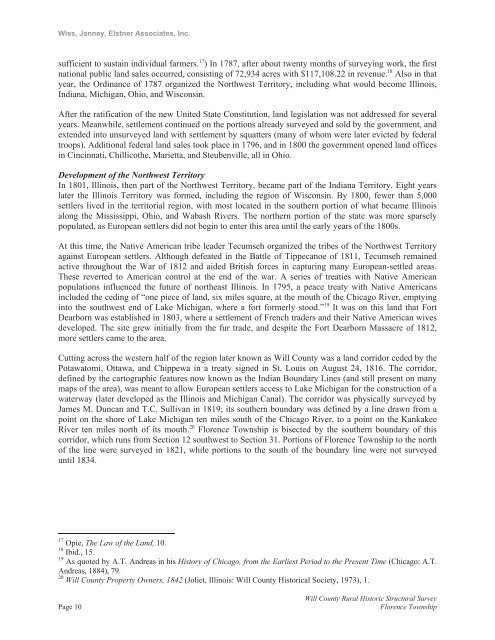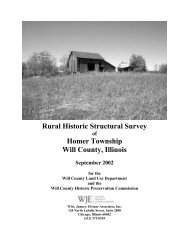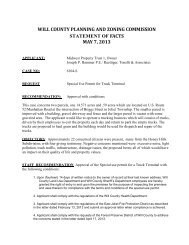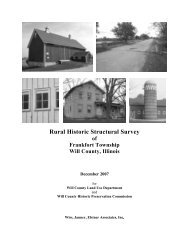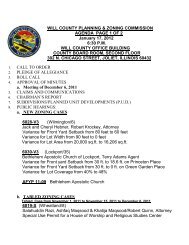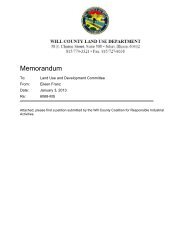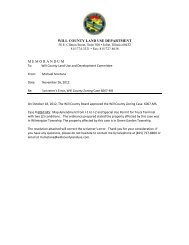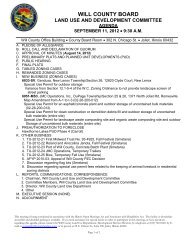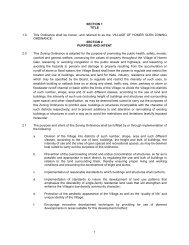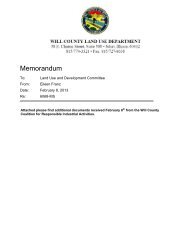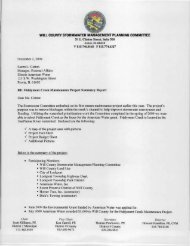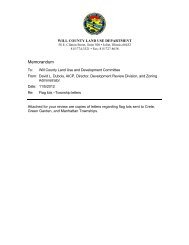Rural H Historic c Struct tural S Survey - Will County Land Use
Rural H Historic c Struct tural S Survey - Will County Land Use
Rural H Historic c Struct tural S Survey - Will County Land Use
Create successful ePaper yourself
Turn your PDF publications into a flip-book with our unique Google optimized e-Paper software.
Wiss, Janney, Elstner Associates, Inc.<br />
sufficient to sustain individual farmers. 17 ) In 1787, after about twenty months of surveying work, the first<br />
national public land sales occurred, consisting of 72,934 acres with $117,108.22 in revenue. 18 Also in that<br />
year, the Ordinance of 1787 organized the Northwest Territory, including what would become Illinois,<br />
Indiana, Michigan, Ohio, and Wisconsin.<br />
After the ratification of the new United State Constitution, land legislation was not addressed for several<br />
years. Meanwhile, settlement continued on the portions already surveyed and sold by the government, and<br />
extended into unsurveyed land with settlement by squatters (many of whom were later evicted by federal<br />
troops). Additional federal land sales took place in 1796, and in 1800 the government opened land offices<br />
in Cincinnati, Chillicothe, Marietta, and Steubenville, all in Ohio.<br />
Development of the Northwest Territory<br />
In 1801, Illinois, then part of the Northwest Territory, became part of the Indiana Territory. Eight years<br />
later the Illinois Territory was formed, including the region of Wisconsin. By 1800, fewer than 5,000<br />
settlers lived in the territorial region, with most located in the southern portion of what became Illinois<br />
along the Mississippi, Ohio, and Wabash Rivers. The northern portion of the state was more sparsely<br />
populated, as European settlers did not begin to enter this area until the early years of the 1800s.<br />
At this time, the Native American tribe leader Tecumseh organized the tribes of the Northwest Territory<br />
against European settlers. Although defeated in the Battle of Tippecanoe of 1811, Tecumseh remained<br />
active throughout the War of 1812 and aided British forces in capturing many European-settled areas.<br />
These reverted to American control at the end of the war. A series of treaties with Native American<br />
populations influenced the future of northeast Illinois. In 1795, a peace treaty with Native Americans<br />
included the ceding of “one piece of land, six miles square, at the mouth of the Chicago River, emptying<br />
into the southwest end of Lake Michigan, where a fort formerly stood.” 19 It was on this land that Fort<br />
Dearborn was established in 1803, where a settlement of French traders and their Native American wives<br />
developed. The site grew initially from the fur trade, and despite the Fort Dearborn Massacre of 1812,<br />
more settlers came to the area.<br />
Cutting across the western half of the region later known as <strong>Will</strong> <strong>County</strong> was a land corridor ceded by the<br />
Potawatomi, Ottawa, and Chippewa in a treaty signed in St. Louis on August 24, 1816. The corridor,<br />
defined by the cartographic features now known as the Indian Boundary Lines (and still present on many<br />
maps of the area), was meant to allow European settlers access to Lake Michigan for the construction of a<br />
waterway (later developed as the Illinois and Michigan Canal). The corridor was physically surveyed by<br />
James M. Duncan and T.C. Sullivan in 1819; its southern boundary was defined by a line drawn from a<br />
point on the shore of Lake Michigan ten miles south of the Chicago River, to a point on the Kankakee<br />
River ten miles north of its mouth. 20 Florence Township is bisected by the southern boundary of this<br />
corridor, which runs from Section 12 southwest to Section 31. Portions of Florence Township to the north<br />
of the line were surveyed in 1821, while portions to the south of the boundary line were not surveyed<br />
until 1834.<br />
17<br />
Opie, The Law of the <strong>Land</strong>, 10.<br />
18<br />
Ibid., 15.<br />
19<br />
As quoted by A.T. Andreas in his History of Chicago, from the Earliest Period to the Present Time (Chicago: A.T.<br />
Andreas, 1884), 79.<br />
20<br />
<strong>Will</strong> <strong>County</strong> Property Owners, 1842 (Joliet, Illinois: <strong>Will</strong> <strong>County</strong> <strong>Historic</strong>al Society, 1973), 1.<br />
<strong>Will</strong> <strong>County</strong> <strong>Rural</strong> <strong>Historic</strong> <strong>Struct</strong>ural <strong>Survey</strong><br />
Page 10 Florence Township


